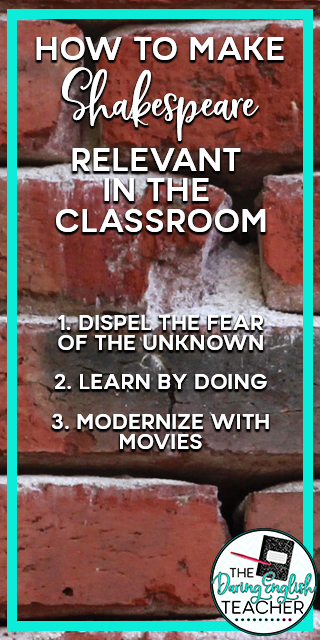So many students have a hard time finding a connection between their 21st-century lives and the works of William Shakespeare. And while his plays were written more than 400 years ago, his messages are timeless. Here are some ways you can make the Bard more relatable to your students.
1. Dispel the Fear of the Unknown
One of the many reasons students dislike Shakespeare is because it is unfamiliar. It can seem strange, ridiculous even, to think someone from the 21st century can even understand someone from 450 years ago, let alone relate to them; and because of this, students will subconsciously distance themselves from the literature before even giving it a try in the first place. To stop this from happening, help students find ways to connect with the situations or characters in the story. For example, Much Ado About Nothing is a play about miscommunication that results in hilarious hijinks. Have students talk about times when miscommunication created a funny situation. Having students bring themselves into the plays can make them seem less alien.
2. Learn by Doing
One of the more difficult things about studying plays in English class is the reading part, especially when it comes to Shakespeare. These works were never meant to be exclusively read; they were meant to be performed. Having students perform the play in the classroom can benefit students with different learning styles. Students with aural and verbal learning styles will benefit from hearing the words said out loud and with the correct emotions, and students with physical and spatial learning styles will benefit from seeing the words in action. If some of your students are shy or not comfortable with performing, you can assign them roles that are smaller and less involved, and vice versa for your more outgoing students. I typically find that some of my shy students prefer the role of narrator because there is no acting involved. Whereas my more outgoing students generally gravitate toward certain characters and like to read their parts for the entire play. In general, having your students up and moving and acting can be a fun way to get your students interested in Shakespeare.
3. Modernize with Movies
This is a combination of my first two points because it brings the plays into the modern world, which makes it easier to digest for the modern teen and because it shows the producers interpretation of the characters. You could show two different versions of Romeo and Juliet movies and have them analyze the choices that were made for each character and how that changes the meaning of the line or the scene. This is helpful for students who are more visual learners. Trying to imagine the play while also trying to figure out the language and keep track of all the characters can be overwhelming for some students. Showing them the movie version of the play may make it easier for those students by putting a face to the name and putting a tone to the words.
As time goes on, it becomes harder and harder for teachers to make William Shakespeare’s work seem relevant to modern students, but with some creativity and understanding, it is possible. You can use all of these suggestions separately or in combination with each other to make it easier for students to learn about the Bard and hopefully enjoy learning about his works.
Shakespeare Teaching Resources:Intro to Shakespeare Mini Flip Book





